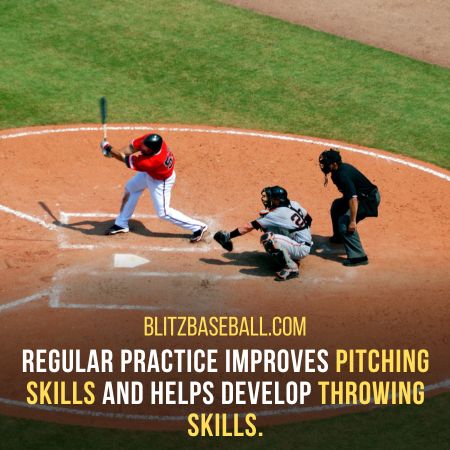If you want to improve your pitching skills, but don’t have a partner to practice with, don’t worry! There are plenty of techniques and drills that you can do on your own to enhance your pitching abilities.
From using a canvas catcher or hitting net to practicing hand drills and seeking advice from professionals, there are various methods to develop accuracy, speed, and technique.
In this article, we will guide you on how to practice pitching alone and become a better pitcher.
Key Takeaways
- There are various techniques for practicing pitching alone, such as using a canvas catcher, hitting net, blanket, football crossbar, batting cage, plywood board, brick wall, or sock.
- Regular practice improves pitching skills and helps develop throwing skills, forearm muscles, and overall pitching technique and accuracy.
- Hand drills can be used to improve pitching and throwing techniques without the need for extra peripherals.
- Other aspects of practicing pitching alone include fielding training, developing patience and motor aptitudes, improving concentration and attention, enhancing teamwork, practicing on pitching mounds, and resolving issues with head movement and elbow alignment. Consistency and self-sufficiency are important, and practice is essential for baseball players.
How To Practice Pitching Alone?
You can try the towel drill technique to improve your pitching accuracy and mechanics.
This technique requires minimal pitching equipment and can be done as part of your solo practice routines.
Start by folding a towel lengthwise and holding it with your throwing hand.
Get into your pitching stance and go through your normal pitching motion, releasing the towel as if you were throwing a pitch.
The towel acts as a visual aid, helping you see any flaws in your mechanics.
Focus on keeping the towel straight and in line with your target, as this will improve your accuracy.
Pay attention to your grip, arm angle, and follow-through.
Repeat this drill regularly to reinforce good pitching habits and develop muscle memory.
Benefits of Practicing Pitching
Regular practice improves your pitching skills, enhances your overall technique, and raises your throwing ability to a higher degree. The benefits of practicing pitching go beyond just improving your game.
It helps in improving accuracy and building muscle strength, which are essential for a successful pitcher. By consistently practicing, you can fine-tune your aim and hit your target with precision.
Additionally, pitching requires a strong throwing arm, and regular practice helps build muscle strength, allowing you to throw with more power and speed. To help you visualize the benefits of practicing pitching, here is a table showcasing the positive outcomes:
| Benefits of Practicing Pitching |
|---|
| Improved accuracy |
| Enhanced muscle strength |
| Increased overall performance |

Hand Drills Development
To develop your hand drills for pitching alone, seek advice from pros, watch tutorials, and ask for assistance from experienced gamers. These techniques will help you improve your pitching skills and enhance your overall technique and accuracy.
Here are four hand drill techniques that you can incorporate into your practice sessions:
-
Grip Strength Drill: Use a grip trainer or a stress ball to strengthen your hand muscles and improve your grip on the baseball. This will increase your control and velocity when throwing pitches.
-
Finger Flexibility Drill: Practice finger exercises such as finger taps and finger curls to improve the flexibility and dexterity of your fingers. This will allow you to throw different types of pitches with better control and movement.
-
Wrist Snap Drill: Focus on snapping your wrist at the release point to generate more spin and movement on your pitches. This drill will help you develop a quicker and more efficient wrist motion.
-
Arm Extension Drill: Work on extending your arm fully during the pitching motion to maximize your reach and create a longer release point. This will give your pitches more downward movement and make them harder for batters to hit.
By incorporating these hand drill techniques into your practice routine, you will see significant improvements in your pitching performance. The benefits of hand drills include increased grip strength, better finger flexibility, improved wrist snap, and enhanced arm extension.

Fundamental Baseball Drills
Improve your fundamental baseball skills by focusing on your responsibility to the entire game as a pitcher.
Building confidence is key in becoming a successful pitcher. To enhance your skills, incorporate drilling techniques into your practice routine.
Start by drilling for balance, which helps create stability in your pitching motion. Practice drilling for tap, which improves the coordination between pitching and speed.
These drills will not only improve your pitching skills but also build your confidence on the mound. Remember, as a pitcher, you have a significant role in the game.
Other Aspects of Practicing Pitching
When practicing pitching alone, don’t forget the importance of fielding practice for pitchers. Fielding training is a crucial aspect of becoming a well-rounded pitcher. It not only improves your ability to field your position but also enhances your overall performance on the mound.
To make the most out of your fielding practice, focus on resolving poor head movement issues. Maintaining proper eye level with the target is crucial for accuracy and control.
Here are four key tips to help you improve your fielding skills:
-
Stay low and ready: Get into a good fielding position with your knees bent and your glove out in front of you. This will allow you to react quickly to any balls hit back at you.
-
Work on your footwork: Practice moving quickly and efficiently to field ground balls and make throws. Proper footwork will help you get into position to make accurate throws to the bases.
-
Practice throwing on the run: As a pitcher, you’ll often need to field a ground ball and make a throw while on the move. Work on your accuracy and arm strength by practicing throwing on the run.
-
Focus on glove work: Pay attention to your glove positioning and technique when fielding ground balls. A clean and quick transfer from glove to hand will help you make faster, more accurate throws.
Importance of Practice
Don’t underestimate the significance of regular practice in enhancing your pitching skills and overall performance on the mound.
Consistent training is key to honing your skills through repetition. By engaging in regular practice sessions, you are building muscle memory, which allows you to perform with precision and accuracy.
Discipline plays a vital role in practice, as it allows you to stay focused and committed to improving your performance. The impact of practice on performance improvement cannot be overstated.
Each practice session presents an opportunity for growth and refinement. Through dedicated practice, you can fine-tune your technique, increase your pitching velocity, and develop the necessary skills to dominate on the mound.

Frequently Asked Questions
What are some common mistakes pitchers make when practicing alone?
Common mistakes pitchers make when practicing alone include neglecting proper form and technique, failing to focus on specific areas of improvement, and not seeking feedback or guidance. Effective drills can help address these issues and enhance pitching skills.
How can pitchers improve their accuracy when practicing alone?
To improve your accuracy when practicing pitching alone, focus on developing consistency by practicing regularly and paying attention to your technique. Work on maintaining proper body alignment and keeping your eye level with the target.
Are there any specific warm-up exercises pitchers should do before practicing alone?
To warm up before practicing pitching alone, incorporate specific routines such as arm circles, shoulder stretches, and light jogging to increase blood flow. Consistency in these warm-up exercises is crucial to prevent injuries and improve performance.
How often should pitchers practice pitching alone to see improvement?
To see improvement in your pitching skills, it is recommended that you practice pitching alone at least 3-4 times a week. Incorporate a variety of pitching drills into your solo practice routine for optimal results.
Are there any safety precautions pitchers should take when practicing alone?
When practicing pitching alone, it’s important to prioritize safety. To prevent injuries, focus on proper pitching mechanics, such as maintaining good posture, a smooth delivery, and avoiding overexertion. Take breaks, warm up properly, and listen to your body to avoid strain and injury.
Conclusion
In conclusion, practicing pitching alone is a valuable way to enhance your skills on the mound. By using various techniques such as the canvas catcher, hitting net, or even a sock, you can improve your accuracy and technique.
Hand drills on a straight surface with a ball are also beneficial for developing your pitching skills. Additionally, fundamental drills focus on building confidence, speed, and balance. Remember to address any issues with head movement and elbow alignment for optimal performance.
Consistency and self-sufficiency are key in becoming a better pitcher. So, get out there and start practicing to become the best pitcher you can be!
